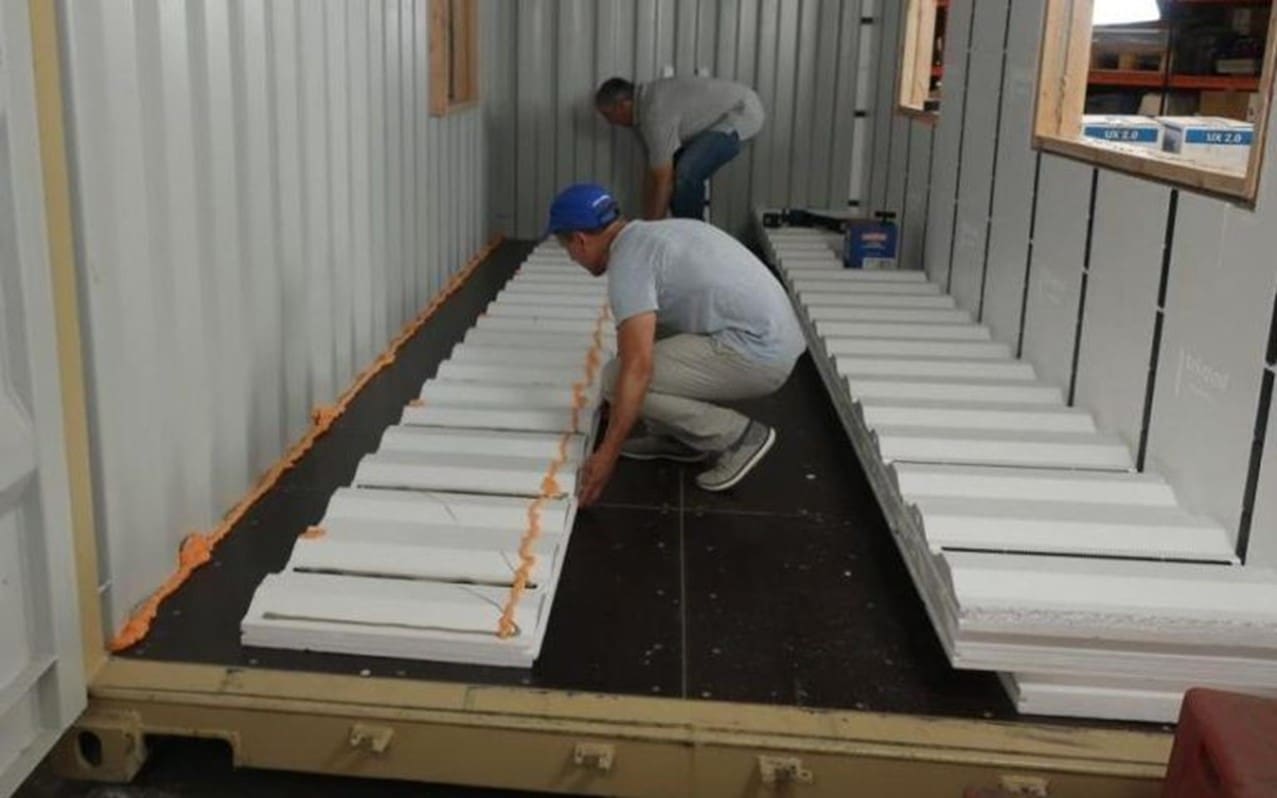Jump to:
Insulating shipping containers has become an increasingly popular topic among shipping container owners, especially those who are repurposing these containers for housing, offices, or other habitable spaces. Proper insulation not only makes these structures more comfortable but also energy-efficient and sustainable. This blog serves as a comprehensive guide to insulating shipping containers, outlining the benefits and providing practical advice for those looking to undertake such a project.
Understanding the Importance of Insulation
Shipping containers are made from Corten Steel, also known as a ‘weathering steel’, as the steel forms a protective layer on its surface under the influence of the weather. Without insulation, the interior of a shipping container can become extremely hot or cold, depending on the outside temperature. This can make the container uncomfortable and lead to increased energy costs if heating or cooling systems are used. Insulation helps to maintain a stable internal temperature, reducing the need for external heating and cooling sources.
Reasons to Insulate a Shipping Container
- Temperature Control – Proper insulation helps regulate the internal temperature of the container, ensuring comfort regardless of external weather conditions.
- Energy Efficiency – Optimizing thermal efficiency by reducing heat loss during cold weather and curbing excessive heat gain in hot regions leads to substantial energy savings.
- Noise Reduction – Enhancing soundproofing within the container also mitigates external noise, resulting in a more tranquil interior environment.”
- Condensation Prevention – When containers experience temperature fluctuations, the metal expands and contracts, creating tiny cracks, crevices and trap moisture causing damage.
5 Things to Consider When Evaluating Insulation Options
- R-value: Measures how well building insulation can prevent the flow of heat into and out of the home. Typical recommendations for exterior walls are R-13 to R-23, while R-30, R-38 and R-49 are common for ceilings and attic spaces. And thus, more savings on your next heating and cooling bill
- Soundproofing: Quality insulation, such as injection foam, can enhance soundproofing
- Flammability: How well it acts as a fire barrier that impedes the spread of flames
- Allergens: Some insulation products can become allergens and pose a significant health risk.
- Cost: Consider cost, labor & equipment depending on if you are installing it yourself or hiring a contractor.
Ready to purchase a shipping container? Reach out today to get a quote from the best in the industry!

Types of Shipping Container Insulation
ROLLED
Blanket (also known as Batt) is pre-cut sections of insulation that are easy to install to keep your container warm. Affordable and good to use for your shipping container as your office or home. However, it does require wood framing installation. Available in a variety of R-Values. Usually made of fiberglass, although cellulose, mineral wool, natural fibers, and plastic versions are available.
Different Types of Blanket (Batt) Insulation:
- Fiberglass
- Cellulose
- Mineral wool
- Natural fibers
SPRAY FOAM
Spray Foam Insulation comes in expanding and non-expanding foam and is a liquid latex or polyurethane foam. Open-cell and closed-cell spray polyurethane are expanding spray foams, but damp spray cellulose and cementitious foam are non-expanding. Expanding spray foam means the insulation expands to fill the area, while non-expanding means the material will be packed to fill the space.
Types of Spray Foam Insulation include:
- Open-Cell Spray Polyurethane
- Closed-Cell Spray Polyurethane
- Damp Spray Cellulose
- Cementitious Foam
LOOSE FILL ( BLOWN-IN)
Loose Fill is also known as Blown-In Insulation and comprises tiny particles of fiber, foam, or other materials. These particles coalesce to create an insulating material that can adapt to any space without disrupting structures.
Types of Loose Fill ( Blown-In) Insulation include:
- Cellulose Insulation
- Loose-Fill Fiberglass Insulation
- Vermiculite Insulation and Perlite Insulation
Rigid Foam Board
Rigid Form Board insulation made from rugged, dense sheets.
Types of Rigid Form Board Insulation include:
- Expanded Polystyrene (EPS) also known as “Styrofoam”.
- Extruded Polystyrene (XPS).
- Polyisocyanurate ( Polyiso, ISO)
Pros and Cons of each type of insulation for a Shipping Container
| Insulation Type | Advantage | Disadvantage |
|---|---|---|
| Rolled – Blanket (Batt) | Do-it-yourself – Relatively inexpensive. Ideal for standard stud & joist spacing | Inadequate results resulting from flawed installation techniques (such as tearing, ripping, and leaving open spaces). The fiberglass can irritate lungs, eyes, and skin. |
| Spray Foam | Highest R-value densities, and can be applied to any surface | Installed by professionals More expensive than other materials |
| Loose Fill (Blown- IN) | Least expensive choice Fills in around pipes and ducts and other irregular shaped areas | As with rolled Blanket (Batt), it can irritate lungs, eyes, and skin. |
| Rigid Foam Board | Requires no special equipment or protection for installer. High Insulating R-value. | Must cut around pipes, etc. and fill joints to maintain airtight enclosure |
Ready to purchase a shipping container? Reach out today to get a quote from the best in the industry!

What Part a Shipping Container Should You Insulate?
Wall Insulation: Insulation acts as a thermal barrier, reducing heat transfer and helping maintain a consistent temperature inside the container. Opt for materials with a high R-value ensures better climate control and energy efficiency. Since there are viable options, including spray foam insulation, fiberglass insulation, rigid foam insulation, and mineral wool insulation choose the one that fits both your budget and specific insulation requirements. Installing stud walls to most shipping container walls allows contractors to run plumbing and electrical service and an attachment point for drywall or other interior surfaces.
Ceiling Insulation: Insulating the roof of your shipping container is essential to minimize heat loss or gain. You have numerous types of insulation to choose from. But don’t forget to consider painting the roof white in color to help prevent heat penetration. An option to consider is an acrylic roof coating to help reflect sunlight and reduce heat transfer.
Floor Insulation: a shipping container floor has 1 ¼” laminated plywood flooring and is in direct contact with the ground, it is prone for heat transfer. comfortable and energy-efficient space. Since the floor is in direct contact with the ground, it is prone to heat transfer. You may want to consider installing rigid foam insulation panels or mineral wool insulation on the underside.
How to Insulate the Exterior of a Shipping Container?
Shipping container walls are corrugated, so you need to use an insulated product to make it flat. Then cover with some type of weather-resistant material such as:
- Wood Siding
- Vinyl Siding
- Metal Siding
How much does it cost to insulate a shipping container?
Price is based on factors such as insulation material, labor rate and project requirements. An average price to insulate a 20 ft. shipping container would be $1,500 to $4,500. For a 40 ft. shipping container can be from $ 2,500 to $6,500
Beyond insulation, how to keep your shipping container cool in the summer and warm in the winter
Installing vents for additional circulation may not be enough if you live in climates with extreme weather. In addition to vents, you can also consider painting the roof white in color to reflect the sun or even build a secondary roof on top of the container to allow a 6” air gap. Here are some of our top selling vent and fan options.
Ready to purchase a shipping container? Reach out today to get a quote from the best in the industry!
Conclusion
Whether you’re converting a shipping container into a living space, office, or any other purpose, insulation plays a vital role in creating a comfortable and energy-efficient environment. It also helps prevent condensation and minimizes heat loss or excessive heat gain, depending on the climate. You can save expensive energy bills by taking the time to plan, research, and understand the importance of selecting the right materials along with following proper installation techniques. Not to mention saving you money on having to fix or replace damaged items from condensation build-up.


